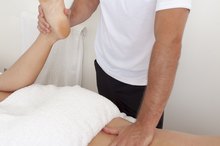Pros & Cons of Inversion Tables
Inversion therapy is nothing new. Hanging upside-down to relieve pain and the effects of gravity have been documented as far back as 400 BC when Hippocrates, the famous physician, observed a patient being hung by his knees and ankles from a ladder to relieve an ailment. Today, inversion therapy commonly uses an inversion table to obtain the health benefits that come from reversing the gravitational pull on the body's organs, bones and joints.
Benefit: Lower Back Pain
A study entitled, "Adaptation of Tilt Table for Lumbar Traction," published in the Journal of Canadian Chiropractic Association, found that 88 percent of patients who underwent a series of eight inversion table treatments found major improvements in a number of complaints including spondylolisthesis, herniated discs, lumbar osteoarthritis with sciatica, and coccygodynia. The study found that inversion treatments help increase the space between spinal discs and reduce paraspinal EMG activity (an indicator of muscle pain).
Reducing the pressure on the spinal discs and increasing disc space has been found to relieve lower back pain. Inversion tables help to stretch and elongate the spinal column, allowing the discs to separate and opening up the vertebral spaces where nerves enter and exit, which enables nerve impulses to travel unhindered to and from the brain.
- A study entitled, "Adaptation of Tilt Table for Lumbar Traction," published in the Journal of Canadian Chiropractic Association, found that 88 percent of patients who underwent a series of eight inversion table treatments found major improvements in a number of complaints including spondylolisthesis, herniated discs, lumbar osteoarthritis with sciatica, and coccygodynia.
- The study found that inversion treatments help increase the space between spinal discs and reduce paraspinal EMG activity (an indicator of muscle pain).
Benefit: Increased Trunk Flexion
What Are the Health Benefits of a Rocking Chair?
Learn More
Another study published in the Journal of the Canadian Chiropractic Association found that inversion therapy increased forward trunk flexion, the ability to bend over forward, by 25 percent. The inability to bend over forward severely restricts some everyday activities like putting on shoes and socks, and contributes to muscle atrophy.
Benefit: Improvement of Other Conditions
The EnergyCenter.com, a seller of inversion tables and equipment, claims that inversion tables can also help reduce tension headaches by taking pressure off nerves, increase flexibility, promote lymphatic drainage and blood circulation, and improve mood. By reversing the effects of gravity, the blood is able to circulate more freely to the upper body, including the brain. Inversion therapy may also be beneficial in recovering from high impact workouts.
Contraindications
What Are the Treatments for Bone Spurs in the Cervical Spine?
Learn More
Inversion therapy is not without complications. For most healthy people, inversion therapy poses few threats. The study published in the Journal of the Canadian Chiropractic Association found no increase in heart rate or blood pressure with inversion therapy. However, there may be an increase in eye pressure and people with retinal detachment are advised against the use of this technique. Other contraindications include stroke, recent head injury, spinal injury or bone weakness. Additionally, inversion tables are not recommended for use by people who have had recent back surgery, glaucoma, herniated discs, high blood pressure, hiatal hernia and other conditions that may be made worse by inversion therapy.
- Inversion therapy is not without complications.
- However, there may be an increase in eye pressure and people with retinal detachment are advised against the use of this technique.
Related Articles
References
- EnergyCenter.com
- National Institutes of Health
- Back And Body Solutions
- Chronic Back Pain. Health Policy Institute. https://hpi.georgetown.edu/backpain/. Published February 13, 2019.
- Wegner I, Widyahening IS, Van tulder MW, et al. Traction for low-back pain with or without sciatica. Cochrane Database Syst Rev. 2013;(8):CD003010. doi:10.1002/14651858.CD003010.pub5
- McMonnies CW. Intraocular pressure and glaucoma: Is physical exercise beneficial or a risk?. J Optom. 2016;9(3):139–147. doi:10.1016/j.optom.2015.12.001
- Chronic Back Pain. Health Policy Institute. Published February 13, 2019.
- Kong L, Tian W, Cao P, Wang H, Zhang B, Shen Y. Predictive factors associated with neck pain in patients with cervical disc degeneration: A cross-sectional study focusing on Modic changes. Medicine (Baltimore). 2017;96(43):e8447. doi:10.1097/MD.0000000000008447
Writer Bio
When not working in her family-owned food and bar business, Viola Horne can almost always be found with a cookbook in one hand and a whisk in the other. Horne never tires of entertaining family and friends with both comfort food and unusual delicacies such as garlic cheese smashed potatoes and banana bacon pancakes.









